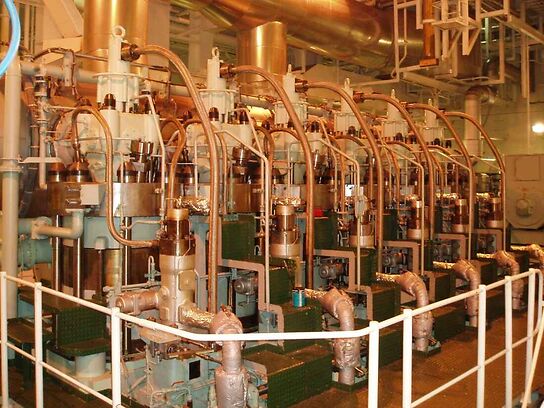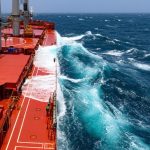At the beginning of the 20th century the near-universal ship-propulsion device was the reciprocating steam engine, furnished with steam from fire-tube boilers in which coal-combustion gases passed through tubes immersed in water. Turbine steam engines, fuel oil, watertube boilers (water within the tubes, combustion gas outside), and diesel engines were first employed in the decade before World War I. Refinements of these innovations continued through the middle third of the century, with the diesel engine gradually supplanting steam for commercial ship propulsion. The sharp increases in petroleum prices in the 1970s gave added significance to diesel’s prime advantage—its superior energy efficiency. The resultant saving in fuel cost was large enough to give the diesel engine the preeminent status in commercial ship propulsion that the reciprocating steam engine had enjoyed in 1900.
Diesel
The diesel engine appears in two distinct types, the medium-speed engine and the low-speed engine. Both operate on the same principles, but each has its own attractions for the ship designer.
The medium-speed engine, characterized by rated speeds in the range of 400–600 revolutions per minute, is in practically all cases a four-stroke engine supercharged by exhaust-driven turbochargers. Power output is proportional to the product of speed and cylinder displacement, and engine size and weight is roughly proportional to cylinder displacement. For a given output, the medium-speed engine is lighter and more compact than the low-speed alternative, and it is usually lower in initial cost. On the other hand, its higher speed nearly always demands a speed-reducing gear between the engine and propeller—a component that is usually unnecessary with low-speed engines. Other handicaps of the medium-speed alternative are a greater number of cylinders for a given power rating and a specific fuel rate (weight of fuel burned per unit of output) that is typically higher than with low-speed engines. On the whole, medium-speed engines are favoured where a particularly heavy or tall engine would be inappropriate and where a lower first cost would outweigh the higher fuel cost.
The low-speed engine is characterized by rated speeds in the range of 80–120 revolutions per minute. In all cases it is a two-stroke engine supercharged by exhaust-gas turbochargers. Whereas medium-speed engines are widely employed ashore, the low-speed engine is almost exclusively a marine engine that is designed to match efficient propeller speeds without recourse to a speed-reducing gear. The consequence of low speed is a longer piston stroke and greater cylinder bore, albeitwith fewer cylinders; the net result is a heavier engine, with a specific weight (weight per unit of output) of about 40 kg (88 pounds) per kilowatt—in contrast to a typical figure of 20 kg (44 pounds) per kilowatt for a medium-speed engine. Nevertheless, low speed and large individual cylinder displacement convey advantage to the low-speed engine, since these features allow the lowest-quality—and hence cheapest—fuel to be burned. Even finely powdered coal and coal-oil slurries have been burned in these engines on an experimental basis.
Height, in particular, is a limiting feature of the low-speed engine. In some types of ship, the extra machinery space will interfere with cargo or passenger space.
High-speed engines, with rated speeds of 900 to 1,200 revolutions per minute, are used in a few cases in ships, but engines of this class are almost always found in small craft such as tugs, fishing vessels, and high-speed ferries.
Combinations of machinery
Advantage can sometimes be gained by forming a propulsion plant from disparate elements. A memorable example was the Titanic, which was built in the early days of steam turbine propulsion. The Titanic was propelled by a pair of reciprocating steam engines that exhausted their steam into a single steam turbine. This technique was known as turbocompounding. Turbocompounding, in the guise of turbocharging, is common in diesel technology. Absent an excessively long stroke, a diesel cylinder cannot fully expand its working fluid. One remedy is to exhaust the cylinder gas into a turbine that drives a compressor that in turn supplies the cylinder charge at high pressure. The major benefit of turbocharging is an increase in the power output of the engine without an increase in its size, save for the small increase that the turbocharger represents. In some instances the cylinder exhaust gas contains more energy than the turbocharger requires, and the surplus may be applied to a second turbine whose output is added to that of the engine’s crankshaft. Such an arrangement is most likely to be found with low-speed engines in ships built since 1980.
Gas turbines also have been combined with diesel engines as independent units—i.e., supplied with their own fuel and working fluid rather than with diesel exhaust gas. This provides the opportunity to combine the high efficiency of a diesel for cruising speeds with the high output of the comparatively light gas turbine when bursts of speed are needed. Such needs rarely exist among commercial vessels, but combined diesel and gas is appropriate for some military vessels.


